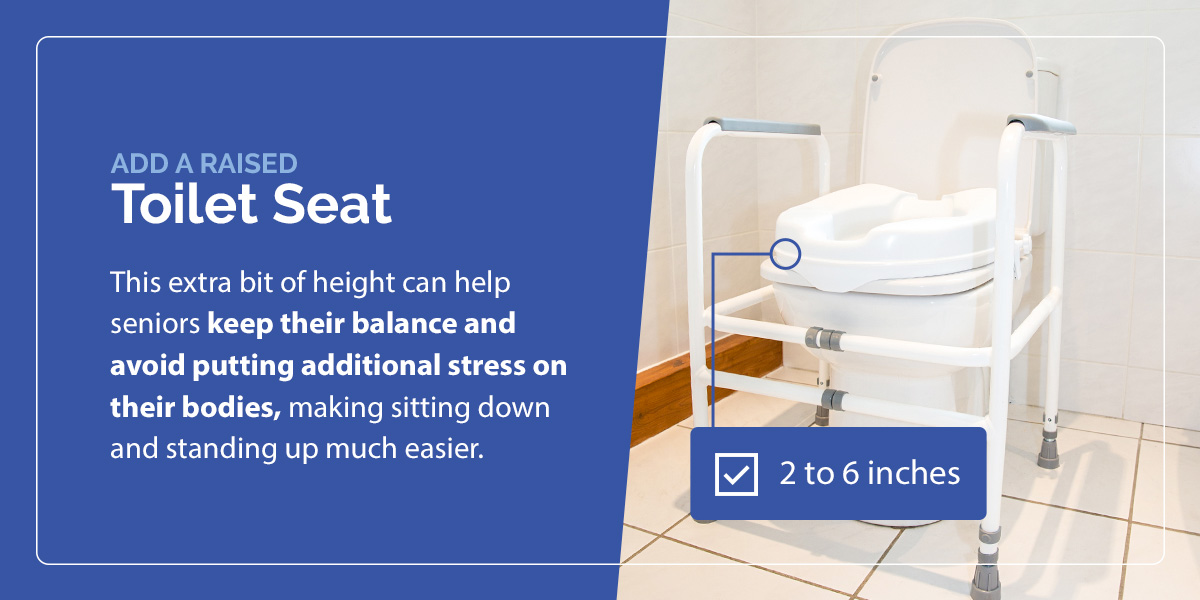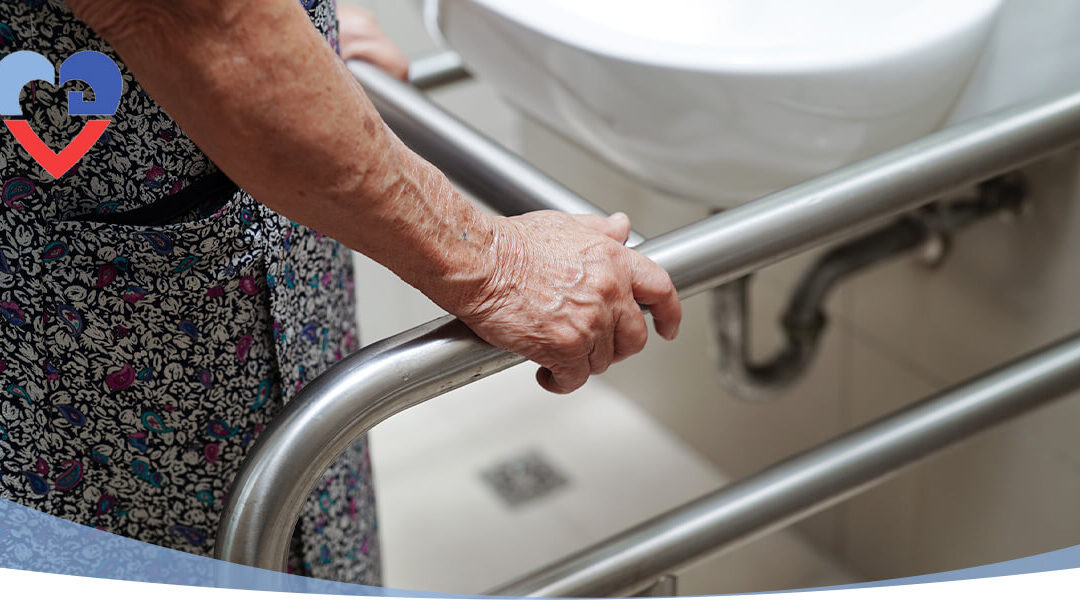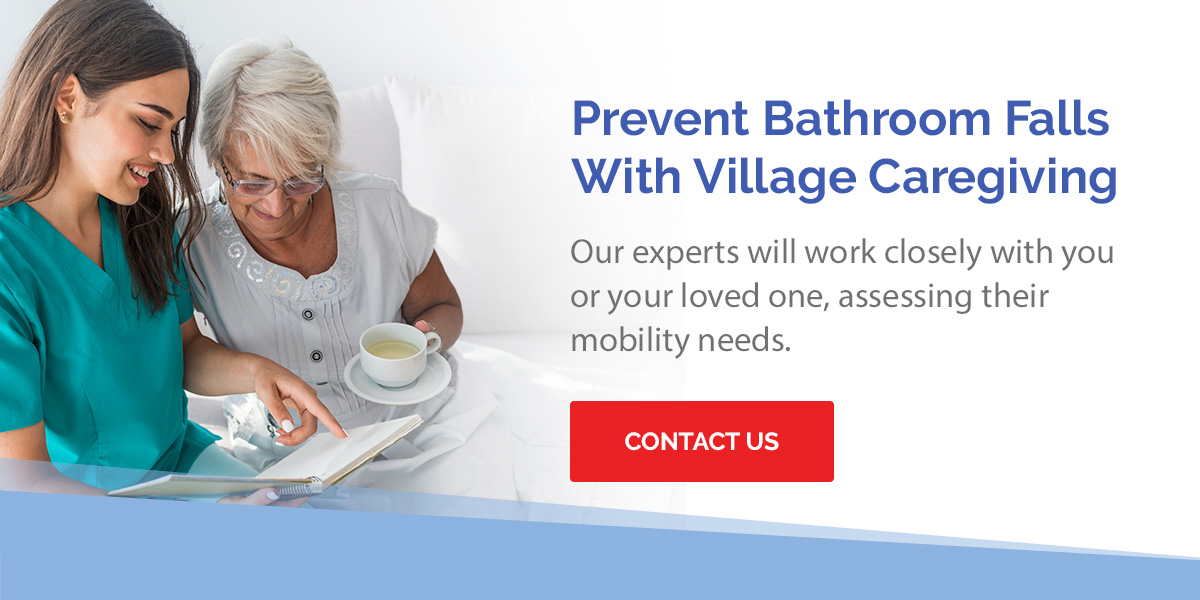Bathrooms can be one of the more hazardous areas of the home, mainly because of the slippery floors and how often they are used. In fact, nearly 80% of falls happen in the bathroom, with over 200,000 seniors requiring a trip to the emergency room each year due to bathroom-related injuries. The good news is that by making some small changes to this space, installing assistive tools and taking proactive measures, one can reduce the risk of falling.
- Install Grab Bars
- Add a Raised Toilet Seat
- Consider Bath and Shower Accessories
- Improve the Lighting
- Declutter and Clean
Learn more about these bathroom safety tips to create a fall prevention plan.
Essential Tools and Modifications for a Safer Bathroom
A few changes in the bathroom can make a big difference in the prevention of falls and injuries. Many mobility products and devices can also help create a safer and more accessible space for older adults.
1. Install Grab Bars
As their name suggests, these bars provide something for seniors to grab onto, which can be incredibly helpful when getting on and off the toilet or in and out of the bathtub or shower. Plus, if one trips or loses their balance, a grab bar can be a vital source of stability, potentially preventing a fall.
Opt for models that can be securely mounted onto the wall, even if this requires professional installation. While suction-cup grab bars may seem convenient, they might not hold up when needed most.
2. Add a Raised Toilet Seat

Some raised toilet seats come with support arms. This feature can be beneficial if one needs to use their upper body strength to lower and lift themselves.
3. Consider Bath and Shower Accessories
A wet bathroom floor from the shower and stepping out of the tub are two of the most common causes of falls, so improving bath and shower safety is paramount:
- Install a walk-in tub: The edge of the tub is a major tripping hazard. Walk-in tubs have a watertight door, eliminating the need for you or your loved one to climb over a high threshold.
- Use a transfer bench: If installing a walk-in tub isn’t feasible, transfer benches are a great alternative. These benches extend over the tub’s edge, with two feet that rest on the bathroom floor. Older adults simply sit on the bench and swing their legs over, allowing them to stand up without having to struggle.
- Put a chair in the shower: Sitting while showering can help reduce the chance of slipping and falling. Ensure the chair has rubber tips on the feet and a nonslip seat for maximum stability.
- Install a hand-held showerhead: Hand-held showerheads allow you to direct the water exactly where it’s needed, which is helpful for those who need to sit while showering.
- Use nonslip mats: These mats provide extra grip, minimizing the risk of slipping on wet surfaces. Placing nonslip mats both inside and around the tub and shower can help prevent falling both during and after bathing or showering.
- Buy a long-handled sponge or brush: Because of their extended handles, these sponges and brushes mean that seniors don’t have to bend and reach when cleaning themselves, reducing the risk of losing their balance.
4. Improve the Lighting
As we get older, we often need to go to the bathroom more frequently, especially at night. Ensuring that the walkways from the bedroom and living areas to the bathroom are well-lit can help lower the likelihood of a fall or injury. Night-lights and motion-sensor lights are both good options.
5. Declutter and Clean
In addition to making upgrades, safety measures in the bathroom involve getting rid of things. As loose rugs are easy to trip over or slip on, removing these creates a clear pathway that reduces the likelihood of a fall. Toilet brushes, scales and trash cans can also be a tripping hazard, so avoid placing these in areas with high foot traffic.
Soap scum and condensation buildup make surfaces slippery. Frequently cleaning grab bars, anti-slip mats, tubs and showers can help avoid this slick residue. You should also wipe up spills as soon as they happen, so store cleaning supplies in the bathroom.
Proactive Measures for a Reduced Risk of Falling
While assistive devices and modifications are essential in making the bathroom a safer environment, it’s also empowering to know that seniors can reduce their general risk of falling by adopting healthy practices.
Here’s how you or your loved one can stay proactive in preventing falls:
- Regular exercise: Activities like tai chi or yoga can help improve balance and mobility. Strength training is also great for building up muscles in the core, hips and legs. Staying active is an excellent goal for all seniors, but it is even more crucial for those with conditions that make them more prone to falls.
- Medication reviews: Blood pressure medications can sometimes lead to lightheadedness or dizziness. If one is already experiencing mobility issues due to arthritis or another condition, such side effects can make walking even tougher. Doctors can help ensure that the overall treatment plan is safe and effective, so schedule a medication review at least once a year.
- Vision and hearing checks: Older adults should book routine checkups to prevent health concerns that increase their fall risk. Eye appointments can help keep their vision sharp. As our ability to hear is vital for our sense of balance, seeing an audiologist is also key.
Home Care Services for Fall Prevention
For seniors with a high fall risk, supervision and support can reduce bathroom accidents and risks even further. While family members can lend a helping hand, one may want to look into professional caregiving for seniors and adults.
In-home care can offer extra peace of mind, with dedicated family caregivers providing services like:
- Mobility assistance to make moving around the bathroom easier and safer.
- Hands-on support during showering and bathing to prevent falls.
- Help with dressing before and after showers or baths.
- Light cleaning of the bathroom to reduce the risk of slipping.
- Assistance with toileting to ensure comfort and safety.
The Importance of Emergency Notification Systems
Even with the best fall prevention plan, it’s important to remember that the risk of falls can’t be completely eliminated. If an older adult does fall, they must receive medical attention as soon as possible.
That’s where emergency notification systems come in, allowing you to call for help after an accident. Install a buzzer in the bathroom to instantly alert family members or caregivers that you or your loved one needs assistance. Investing in a wearable medical alert device is also a smart move, especially when older adults are home alone. These devices can be worn around the neck or wrist and feature a button that connects the wearer to a 24/7 call center.
Prevent Bathroom Falls With Village Caregiving
Making changes in the bathroom, looking after one’s physical condition and hiring in-home support can all promote mobility and reduce the risk of falling. Because falls can lead to fractures, head injuries and hospitalizations that can impact your independence and have other serious consequences, fall prevention is essential. So, when looking at home care options, you want to choose an agency you feel completely confident in.
Village Caregiving is the largest privately owned home care agency in the country. We specialize in elderly care and safety, providing services like ambulation, help with bathing and hygiene, and housekeeping. Our experts will work closely with you or your loved one, assessing their mobility needs and identifying any potential hazards in the bathroom. They’ll then make recommendations to create a safer environment, from hand-held showerheads to transfer benches, and build a personalized care plan.
To learn more about how we can offer support to prevent falls, contact us today!



Recent Comments